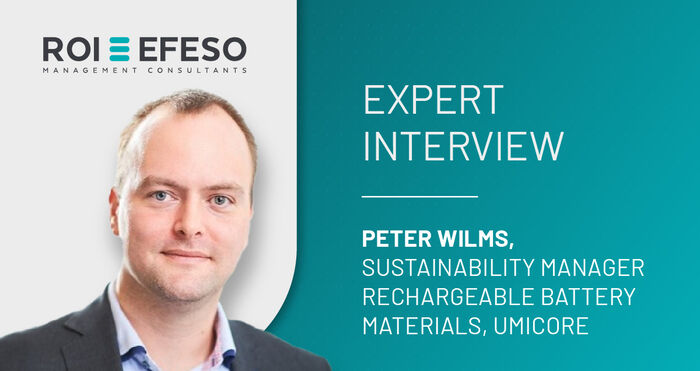“It’s about achieving sustainability targets and creating financial value at the same time.”
Experte: Peter Wilms, Sustainability Manager Rechargeable Battery Materials, Umicore | 04/25/2024 | Teilen auf in

Mr. Wilms, what transformation journey is Umicore on in terms of sustainability?
PW: We are a circular materials technology company with extensive expertise in material science, chemistry and metallurgy. Our main goal of sustainable value creation is based on the ambition to develop, produce and recycle materials in a way that fulfills our mission: "materials for a better life".
That is why we are more determined than ever to leverage our unique, mutually reinforcing portfolio of activities and our closed-loop business model to follow multiple goals: For example, to accelerate the transformation of mobility, to meet the increasing demand for advanced materials and to enable an even more circular economy for critical metals. Every day, more than 11,000 colleagues around the world work hard to bring our mission to life.
Two years ago, we set very ambitious targets for our scope 1 and 2 GHG (Greenhouse Gas) emissions to become carbon-neutral by 2035. To this end, we are pursuing two milestones: achieving reductions compared to our 2019 baseline of 20% by 2025 and 50% by 2030. Additionally, our scope 3 GHG emission target is to reduce the carbon intensity of our purchased materials by 42% by 2030. This target is even more ambitious if you consider the exponential business growth projected in our "RISE 2030 strategy".
Is there an example from your global plant network of how this GHG transformation is already being implemented?
PW: Yes, our plant in Jiangmen, China, is one of our lighthouse projects. Like all units in our organization, the site has received clear GHG emission reduction targets: the ambition is to reduce steam consumption by 70% by 2026. Of course, the site itself had already been putting measures in place towards this target, but there was still some need to determine additional initiatives to reach this target. To support the site on its own “Hero Journey”, we decided in 2023 to launch a project with EFESO and DB Energy to develop a roadmap achieving the envisioned target.
What are the main steps of the collaboration in this project? And what results have already been achieved?
PW: We started with a plant energy walk-through of approx. one week to get a clear picture of the status quo and suitable measures. The project team carried out this scan and came up with a list of four quick wins and twenty more complex projects – six of which appeared to be most relevant. After just one week, we knew exactly where the most effective starting points for reducing emissions were – and where it was not worth investing time and money for the time being.
The quick wins were implemented within two months and were mainly changes to process parameters, which helped us generate direct savings. We carried out a pinch analysis for the six more complex projects linked to CapEx spend. This enabled us to do a feasibility check and confirm assumptions around the business case.
Our last step was in September 2023, when we developed the CapEx roadmap with EFESO. Here, we determined the best possible sequence of projects considering the site’s technology roadmap and overall multi-year business plan. Additionally, we compared different scenarios against each other for this purpose. This might sound simple, but it is crucial for the success of such projects – especially in a dynamic market environment like the one we operate in. This allowed us to define the right moments for launching the right initiatives.
To what extent is the Jiangmen site already making progress with these projects?
PW: Well, as mentioned, the quick wins were modifications to process parameters, which we rapidly tested and implemented. For the changes in asset structure, one of the main projects was the installation of a heat ring to connect the different assets’ peaks and lows of heat. As quite typical in the process industry, each unit was considered separately and optimized for process efficiency – without a holistic view on energy balance.
With an increased focus on these aspects, it is possible to combine proven concepts with new technology. In this case, we created district heating systems from distributed heating sources and installed a buffer tank to store energy when it is not needed. The totality of measures – both implemented and to be installed – will help us reduce steam consumption by 76% in 2026 compared to a “do nothing” scenario. On top of that, the energy efficiency investments had a very attractive payback of less than two years. And that's exactly what it's all about: achieving sustainability targets and creating financial value at the same time.
What experiences or lessons from the transformation process can you share?
PW: Firstly, bring in specialized skills to leverage full value. It’s a complex topic, so you need fresh ideas and to challenge assumptions. Secondly, engage the shop floor on the journey and be brave when making changes. Transformation heroes like to experiment, to try, fail, try again, and succeed – and as an organization, you must create the right environment for this, for example, in the management culture. Finally, push the status quo with ambitious ideas but also balance those ideas with realistic and proven solutions.
About Umicore
Umicore NV/SA is a Belgian materials technology and recycling group headquartered in Brussels. The company employs over 11,000 employees at 45 production sites worldwide.
|
|
Thank you for Signing Up |


